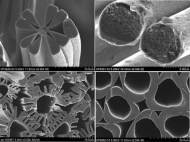Converting polyethylene into carbon fiber
 Researchers at the Department of Energy’s Oak Ridge National Laboratory developed a process that can be used to convert polyethylene into carbon fiber. Polyethylene is the most common plastic material, with annual production of approximately 80 million metric tons, and it is used for all sorts of packaging. The process is very useful since the material accumulates in nature because it isn’t biodegradable without special treatment.
Researchers at the Department of Energy’s Oak Ridge National Laboratory developed a process that can be used to convert polyethylene into carbon fiber. Polyethylene is the most common plastic material, with annual production of approximately 80 million metric tons, and it is used for all sorts of packaging. The process is very useful since the material accumulates in nature because it isn’t biodegradable without special treatment.
“Our results represent what we believe will one day provide industry with a flexible technique for producing technologically innovative fibers in myriad configurations such as fiber bundle or non-woven mat assemblies”, said team leader Amit Naskar of the Materials Science and Technology Division.
Using a combination of multi-component fiber spinning and their sulfonation technique, the researchers were able not only to convert polyethylene into carbon fiber, but also tailor the final product to specific applications by polyethylene-base fibers with a customized surface contour and manipulate filament diameter down to the submicron scale. The process also allows them to tune the porosity, making the material potentially useful for filtration, catalysis and electrochemical energy harvesting.
Naskar noted that the sulfonation process allows for great flexibility as the carbon fibers exhibit properties that are dictated by processing conditions. As a demonstration, the ORNL researchers produced carbon fibers with unique cross-sectional geometry, from hollow circular to gear-shaped by using a multi-component melt extrusion-based fiber spinning method.
“We dip the fiber bundle into an acid containing a chemical bath where it reacts and forms a black fiber that no longer will melt”, said Naskar. “It is this sulfonation reaction that transforms the plastic fiber into an infusible form. At this stage, the plastic molecules bond, and with further heating cannot melt or flow. At very high temperatures, this fiber retains mostly carbon and all other elements volatize off in different gas or compound forms.”
Since polyethylene has various applications such as grocery store plastic bags, carpet backing scraps and salvage, vibration damping and insulation, as a barrier or buoyancy component, or as material for cushioning, it is abundant and inexpensive.
The process that converts this non-biodegradable material is interesting because it could lead to lower cost of carbon fiber, thus widening its application. Hopefully, it will lower it enough to enable more common production of lightweight vehicles that would also lower fuel consumption without compromise in safety or comfort.
For more information, read the paper published in the journal Advanced Materials: “Patterned functional carbon fibers from polyethylene”.









Leave your response!